Elements of Eighteenth-century Haiti
VerifiedAdded on 2022/08/22
|7
|1459
|17
AI Summary
Contribute Materials
Your contribution can guide someone’s learning journey. Share your
documents today.

Running head: ELEMENTS OF EIGHTEENTH-CENTURY HAITI
ELEMENTS OF EIGHTEENTH-CENTURY HAITI
Name of the Student:
Name of the University:
Author Note:
ELEMENTS OF EIGHTEENTH-CENTURY HAITI
Name of the Student:
Name of the University:
Author Note:
Secure Best Marks with AI Grader
Need help grading? Try our AI Grader for instant feedback on your assignments.
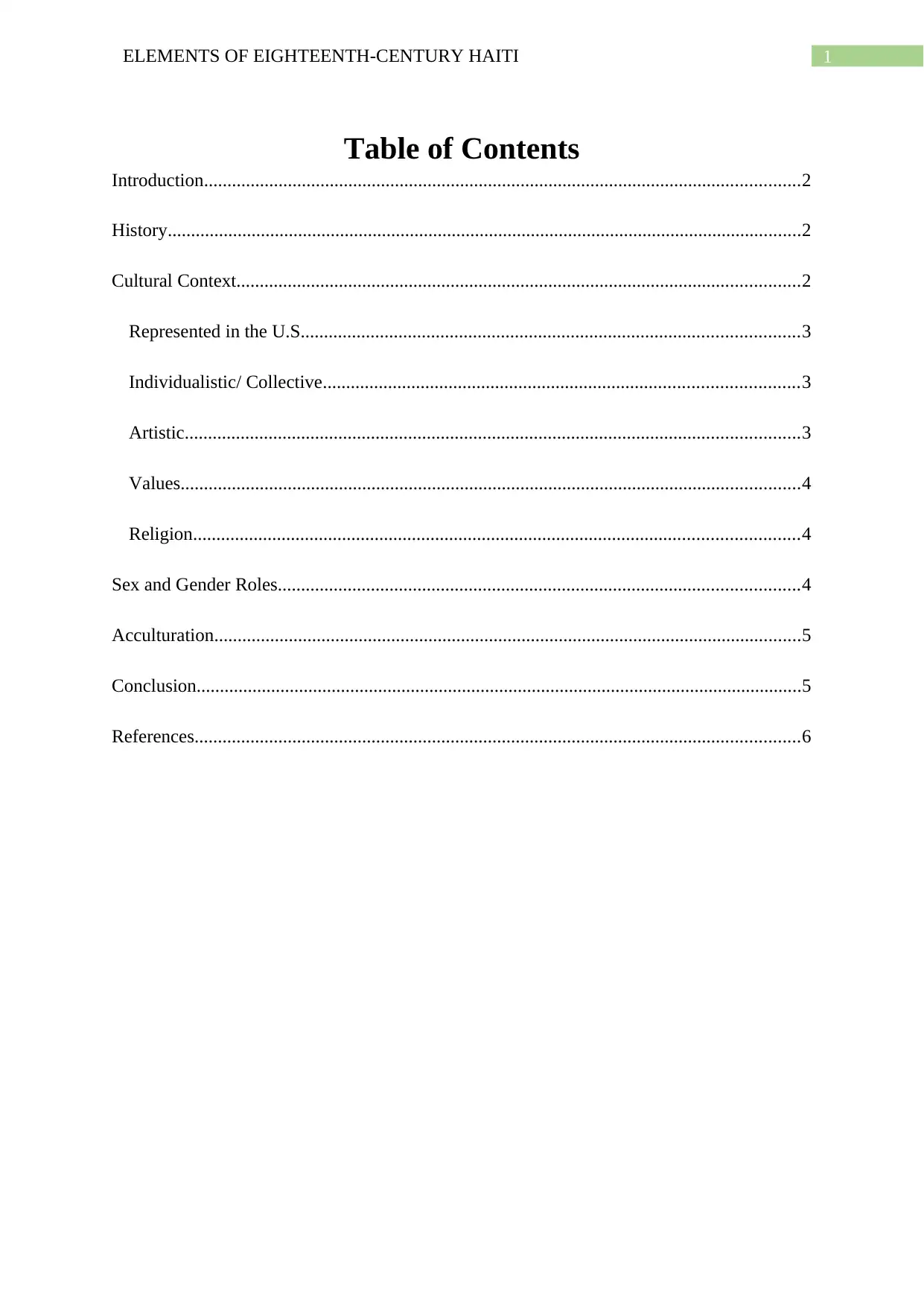
1ELEMENTS OF EIGHTEENTH-CENTURY HAITI
Table of Contents
Introduction................................................................................................................................2
History........................................................................................................................................2
Cultural Context.........................................................................................................................2
Represented in the U.S...........................................................................................................3
Individualistic/ Collective......................................................................................................3
Artistic....................................................................................................................................3
Values.....................................................................................................................................4
Religion..................................................................................................................................4
Sex and Gender Roles................................................................................................................4
Acculturation..............................................................................................................................5
Conclusion..................................................................................................................................5
References..................................................................................................................................6
Table of Contents
Introduction................................................................................................................................2
History........................................................................................................................................2
Cultural Context.........................................................................................................................2
Represented in the U.S...........................................................................................................3
Individualistic/ Collective......................................................................................................3
Artistic....................................................................................................................................3
Values.....................................................................................................................................4
Religion..................................................................................................................................4
Sex and Gender Roles................................................................................................................4
Acculturation..............................................................................................................................5
Conclusion..................................................................................................................................5
References..................................................................................................................................6
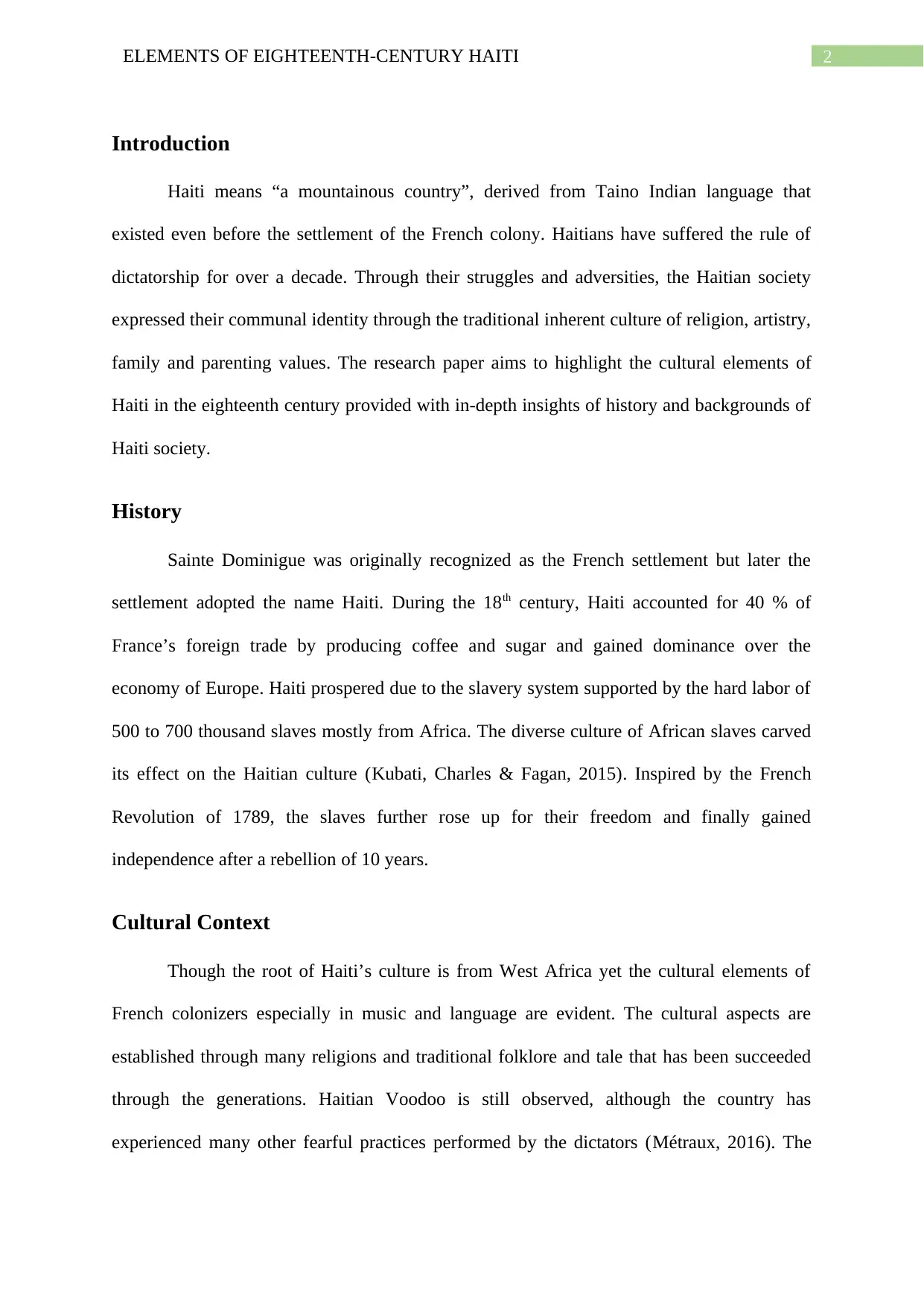
2ELEMENTS OF EIGHTEENTH-CENTURY HAITI
Introduction
Haiti means “a mountainous country”, derived from Taino Indian language that
existed even before the settlement of the French colony. Haitians have suffered the rule of
dictatorship for over a decade. Through their struggles and adversities, the Haitian society
expressed their communal identity through the traditional inherent culture of religion, artistry,
family and parenting values. The research paper aims to highlight the cultural elements of
Haiti in the eighteenth century provided with in-depth insights of history and backgrounds of
Haiti society.
History
Sainte Dominigue was originally recognized as the French settlement but later the
settlement adopted the name Haiti. During the 18th century, Haiti accounted for 40 % of
France’s foreign trade by producing coffee and sugar and gained dominance over the
economy of Europe. Haiti prospered due to the slavery system supported by the hard labor of
500 to 700 thousand slaves mostly from Africa. The diverse culture of African slaves carved
its effect on the Haitian culture (Kubati, Charles & Fagan, 2015). Inspired by the French
Revolution of 1789, the slaves further rose up for their freedom and finally gained
independence after a rebellion of 10 years.
Cultural Context
Though the root of Haiti’s culture is from West Africa yet the cultural elements of
French colonizers especially in music and language are evident. The cultural aspects are
established through many religions and traditional folklore and tale that has been succeeded
through the generations. Haitian Voodoo is still observed, although the country has
experienced many other fearful practices performed by the dictators (Métraux, 2016). The
Introduction
Haiti means “a mountainous country”, derived from Taino Indian language that
existed even before the settlement of the French colony. Haitians have suffered the rule of
dictatorship for over a decade. Through their struggles and adversities, the Haitian society
expressed their communal identity through the traditional inherent culture of religion, artistry,
family and parenting values. The research paper aims to highlight the cultural elements of
Haiti in the eighteenth century provided with in-depth insights of history and backgrounds of
Haiti society.
History
Sainte Dominigue was originally recognized as the French settlement but later the
settlement adopted the name Haiti. During the 18th century, Haiti accounted for 40 % of
France’s foreign trade by producing coffee and sugar and gained dominance over the
economy of Europe. Haiti prospered due to the slavery system supported by the hard labor of
500 to 700 thousand slaves mostly from Africa. The diverse culture of African slaves carved
its effect on the Haitian culture (Kubati, Charles & Fagan, 2015). Inspired by the French
Revolution of 1789, the slaves further rose up for their freedom and finally gained
independence after a rebellion of 10 years.
Cultural Context
Though the root of Haiti’s culture is from West Africa yet the cultural elements of
French colonizers especially in music and language are evident. The cultural aspects are
established through many religions and traditional folklore and tale that has been succeeded
through the generations. Haitian Voodoo is still observed, although the country has
experienced many other fearful practices performed by the dictators (Métraux, 2016). The
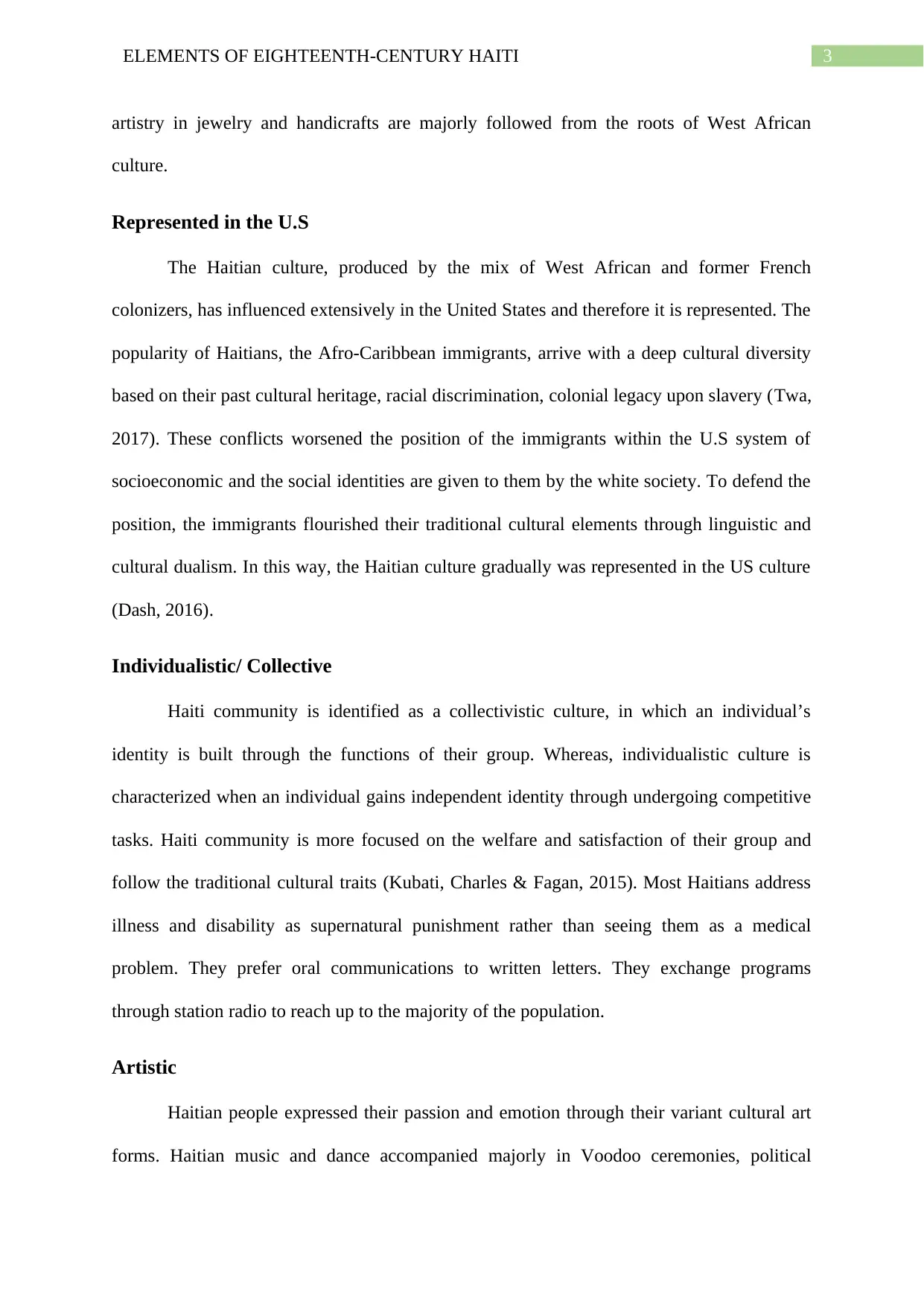
3ELEMENTS OF EIGHTEENTH-CENTURY HAITI
artistry in jewelry and handicrafts are majorly followed from the roots of West African
culture.
Represented in the U.S
The Haitian culture, produced by the mix of West African and former French
colonizers, has influenced extensively in the United States and therefore it is represented. The
popularity of Haitians, the Afro-Caribbean immigrants, arrive with a deep cultural diversity
based on their past cultural heritage, racial discrimination, colonial legacy upon slavery (Twa,
2017). These conflicts worsened the position of the immigrants within the U.S system of
socioeconomic and the social identities are given to them by the white society. To defend the
position, the immigrants flourished their traditional cultural elements through linguistic and
cultural dualism. In this way, the Haitian culture gradually was represented in the US culture
(Dash, 2016).
Individualistic/ Collective
Haiti community is identified as a collectivistic culture, in which an individual’s
identity is built through the functions of their group. Whereas, individualistic culture is
characterized when an individual gains independent identity through undergoing competitive
tasks. Haiti community is more focused on the welfare and satisfaction of their group and
follow the traditional cultural traits (Kubati, Charles & Fagan, 2015). Most Haitians address
illness and disability as supernatural punishment rather than seeing them as a medical
problem. They prefer oral communications to written letters. They exchange programs
through station radio to reach up to the majority of the population.
Artistic
Haitian people expressed their passion and emotion through their variant cultural art
forms. Haitian music and dance accompanied majorly in Voodoo ceremonies, political
artistry in jewelry and handicrafts are majorly followed from the roots of West African
culture.
Represented in the U.S
The Haitian culture, produced by the mix of West African and former French
colonizers, has influenced extensively in the United States and therefore it is represented. The
popularity of Haitians, the Afro-Caribbean immigrants, arrive with a deep cultural diversity
based on their past cultural heritage, racial discrimination, colonial legacy upon slavery (Twa,
2017). These conflicts worsened the position of the immigrants within the U.S system of
socioeconomic and the social identities are given to them by the white society. To defend the
position, the immigrants flourished their traditional cultural elements through linguistic and
cultural dualism. In this way, the Haitian culture gradually was represented in the US culture
(Dash, 2016).
Individualistic/ Collective
Haiti community is identified as a collectivistic culture, in which an individual’s
identity is built through the functions of their group. Whereas, individualistic culture is
characterized when an individual gains independent identity through undergoing competitive
tasks. Haiti community is more focused on the welfare and satisfaction of their group and
follow the traditional cultural traits (Kubati, Charles & Fagan, 2015). Most Haitians address
illness and disability as supernatural punishment rather than seeing them as a medical
problem. They prefer oral communications to written letters. They exchange programs
through station radio to reach up to the majority of the population.
Artistic
Haitian people expressed their passion and emotion through their variant cultural art
forms. Haitian music and dance accompanied majorly in Voodoo ceremonies, political
Secure Best Marks with AI Grader
Need help grading? Try our AI Grader for instant feedback on your assignments.
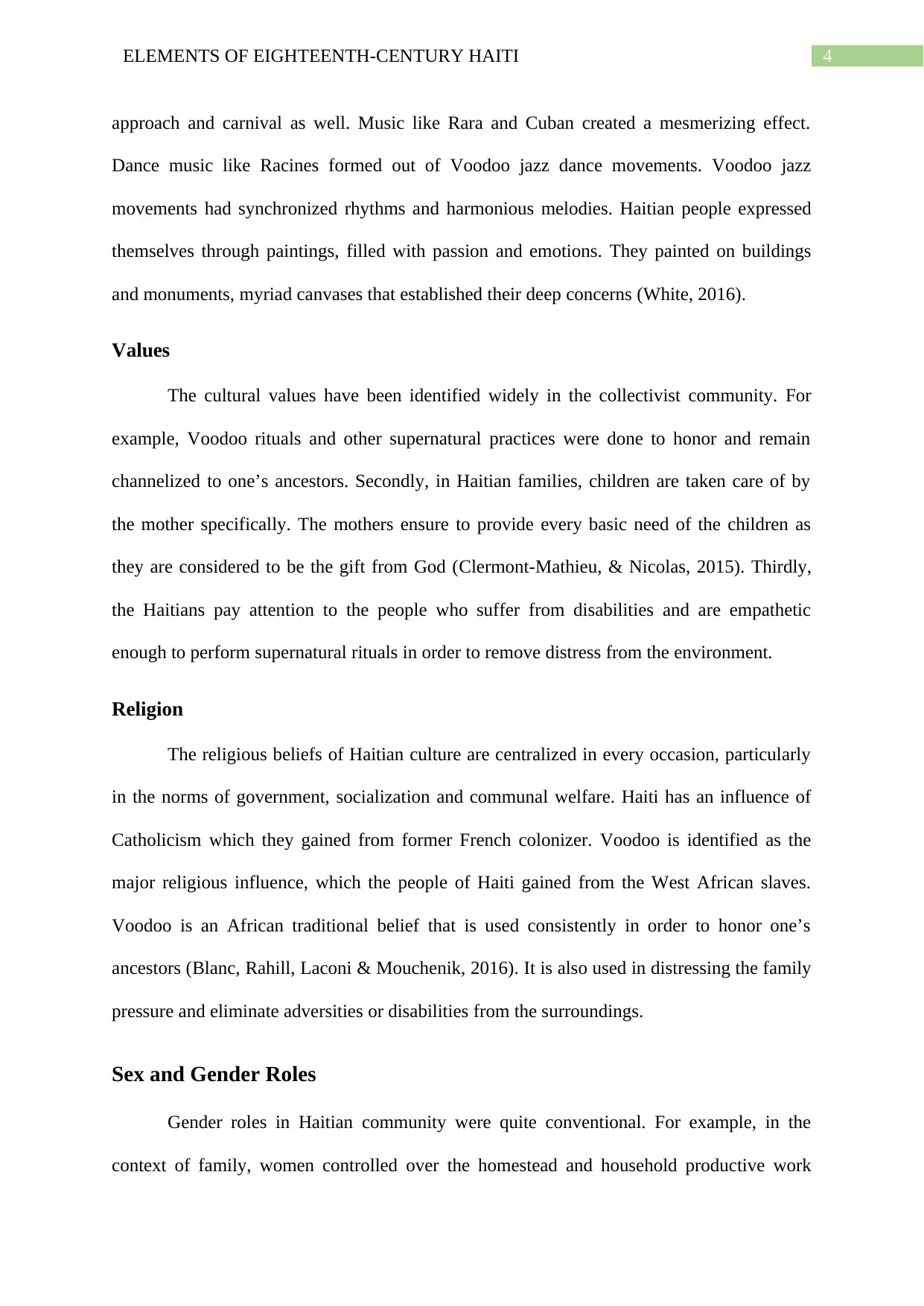
4ELEMENTS OF EIGHTEENTH-CENTURY HAITI
approach and carnival as well. Music like Rara and Cuban created a mesmerizing effect.
Dance music like Racines formed out of Voodoo jazz dance movements. Voodoo jazz
movements had synchronized rhythms and harmonious melodies. Haitian people expressed
themselves through paintings, filled with passion and emotions. They painted on buildings
and monuments, myriad canvases that established their deep concerns (White, 2016).
Values
The cultural values have been identified widely in the collectivist community. For
example, Voodoo rituals and other supernatural practices were done to honor and remain
channelized to one’s ancestors. Secondly, in Haitian families, children are taken care of by
the mother specifically. The mothers ensure to provide every basic need of the children as
they are considered to be the gift from God (Clermont-Mathieu, & Nicolas, 2015). Thirdly,
the Haitians pay attention to the people who suffer from disabilities and are empathetic
enough to perform supernatural rituals in order to remove distress from the environment.
Religion
The religious beliefs of Haitian culture are centralized in every occasion, particularly
in the norms of government, socialization and communal welfare. Haiti has an influence of
Catholicism which they gained from former French colonizer. Voodoo is identified as the
major religious influence, which the people of Haiti gained from the West African slaves.
Voodoo is an African traditional belief that is used consistently in order to honor one’s
ancestors (Blanc, Rahill, Laconi & Mouchenik, 2016). It is also used in distressing the family
pressure and eliminate adversities or disabilities from the surroundings.
Sex and Gender Roles
Gender roles in Haitian community were quite conventional. For example, in the
context of family, women controlled over the homestead and household productive work
approach and carnival as well. Music like Rara and Cuban created a mesmerizing effect.
Dance music like Racines formed out of Voodoo jazz dance movements. Voodoo jazz
movements had synchronized rhythms and harmonious melodies. Haitian people expressed
themselves through paintings, filled with passion and emotions. They painted on buildings
and monuments, myriad canvases that established their deep concerns (White, 2016).
Values
The cultural values have been identified widely in the collectivist community. For
example, Voodoo rituals and other supernatural practices were done to honor and remain
channelized to one’s ancestors. Secondly, in Haitian families, children are taken care of by
the mother specifically. The mothers ensure to provide every basic need of the children as
they are considered to be the gift from God (Clermont-Mathieu, & Nicolas, 2015). Thirdly,
the Haitians pay attention to the people who suffer from disabilities and are empathetic
enough to perform supernatural rituals in order to remove distress from the environment.
Religion
The religious beliefs of Haitian culture are centralized in every occasion, particularly
in the norms of government, socialization and communal welfare. Haiti has an influence of
Catholicism which they gained from former French colonizer. Voodoo is identified as the
major religious influence, which the people of Haiti gained from the West African slaves.
Voodoo is an African traditional belief that is used consistently in order to honor one’s
ancestors (Blanc, Rahill, Laconi & Mouchenik, 2016). It is also used in distressing the family
pressure and eliminate adversities or disabilities from the surroundings.
Sex and Gender Roles
Gender roles in Haitian community were quite conventional. For example, in the
context of family, women controlled over the homestead and household productive work
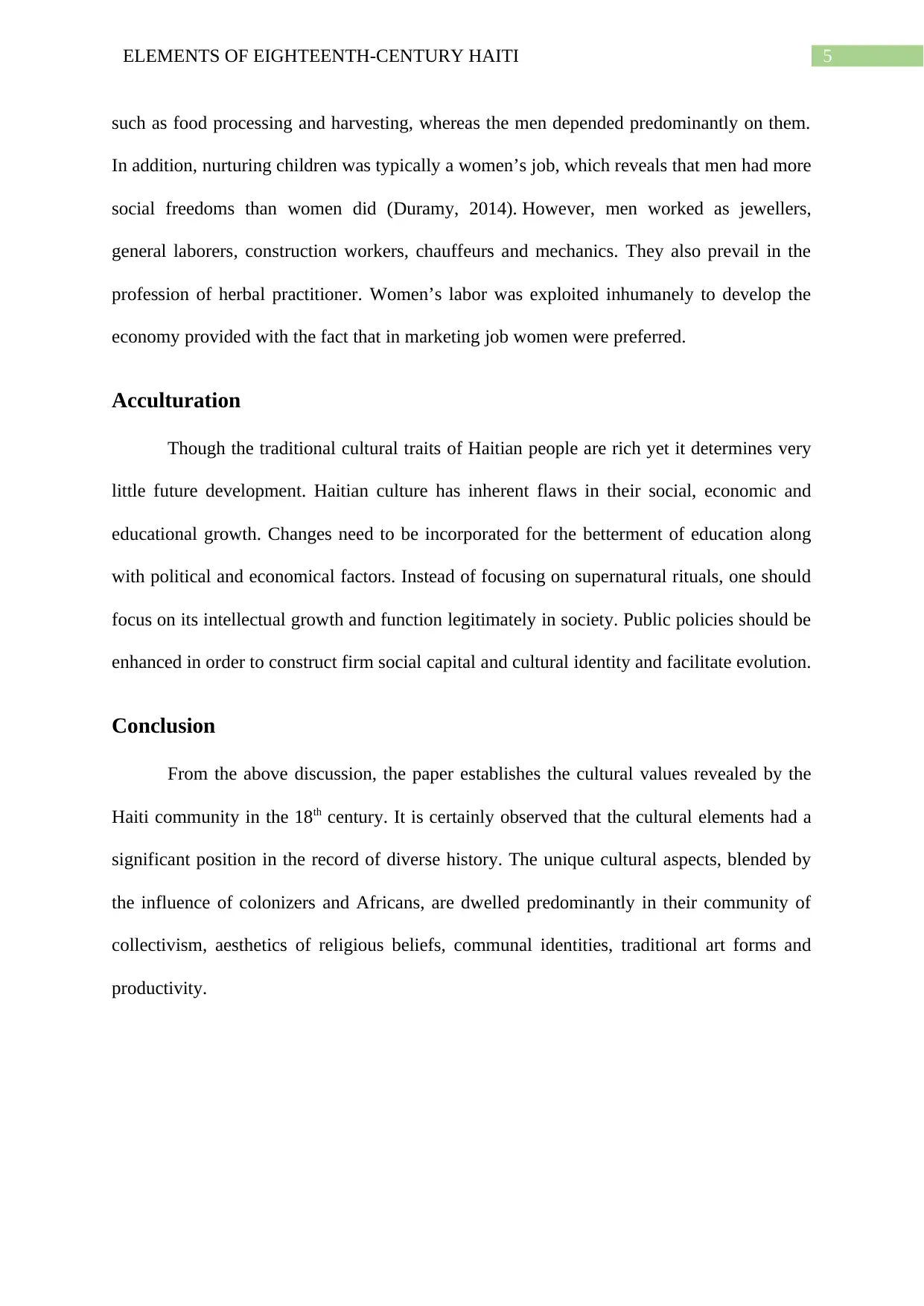
5ELEMENTS OF EIGHTEENTH-CENTURY HAITI
such as food processing and harvesting, whereas the men depended predominantly on them.
In addition, nurturing children was typically a women’s job, which reveals that men had more
social freedoms than women did (Duramy, 2014). However, men worked as jewellers,
general laborers, construction workers, chauffeurs and mechanics. They also prevail in the
profession of herbal practitioner. Women’s labor was exploited inhumanely to develop the
economy provided with the fact that in marketing job women were preferred.
Acculturation
Though the traditional cultural traits of Haitian people are rich yet it determines very
little future development. Haitian culture has inherent flaws in their social, economic and
educational growth. Changes need to be incorporated for the betterment of education along
with political and economical factors. Instead of focusing on supernatural rituals, one should
focus on its intellectual growth and function legitimately in society. Public policies should be
enhanced in order to construct firm social capital and cultural identity and facilitate evolution.
Conclusion
From the above discussion, the paper establishes the cultural values revealed by the
Haiti community in the 18th century. It is certainly observed that the cultural elements had a
significant position in the record of diverse history. The unique cultural aspects, blended by
the influence of colonizers and Africans, are dwelled predominantly in their community of
collectivism, aesthetics of religious beliefs, communal identities, traditional art forms and
productivity.
such as food processing and harvesting, whereas the men depended predominantly on them.
In addition, nurturing children was typically a women’s job, which reveals that men had more
social freedoms than women did (Duramy, 2014). However, men worked as jewellers,
general laborers, construction workers, chauffeurs and mechanics. They also prevail in the
profession of herbal practitioner. Women’s labor was exploited inhumanely to develop the
economy provided with the fact that in marketing job women were preferred.
Acculturation
Though the traditional cultural traits of Haitian people are rich yet it determines very
little future development. Haitian culture has inherent flaws in their social, economic and
educational growth. Changes need to be incorporated for the betterment of education along
with political and economical factors. Instead of focusing on supernatural rituals, one should
focus on its intellectual growth and function legitimately in society. Public policies should be
enhanced in order to construct firm social capital and cultural identity and facilitate evolution.
Conclusion
From the above discussion, the paper establishes the cultural values revealed by the
Haiti community in the 18th century. It is certainly observed that the cultural elements had a
significant position in the record of diverse history. The unique cultural aspects, blended by
the influence of colonizers and Africans, are dwelled predominantly in their community of
collectivism, aesthetics of religious beliefs, communal identities, traditional art forms and
productivity.
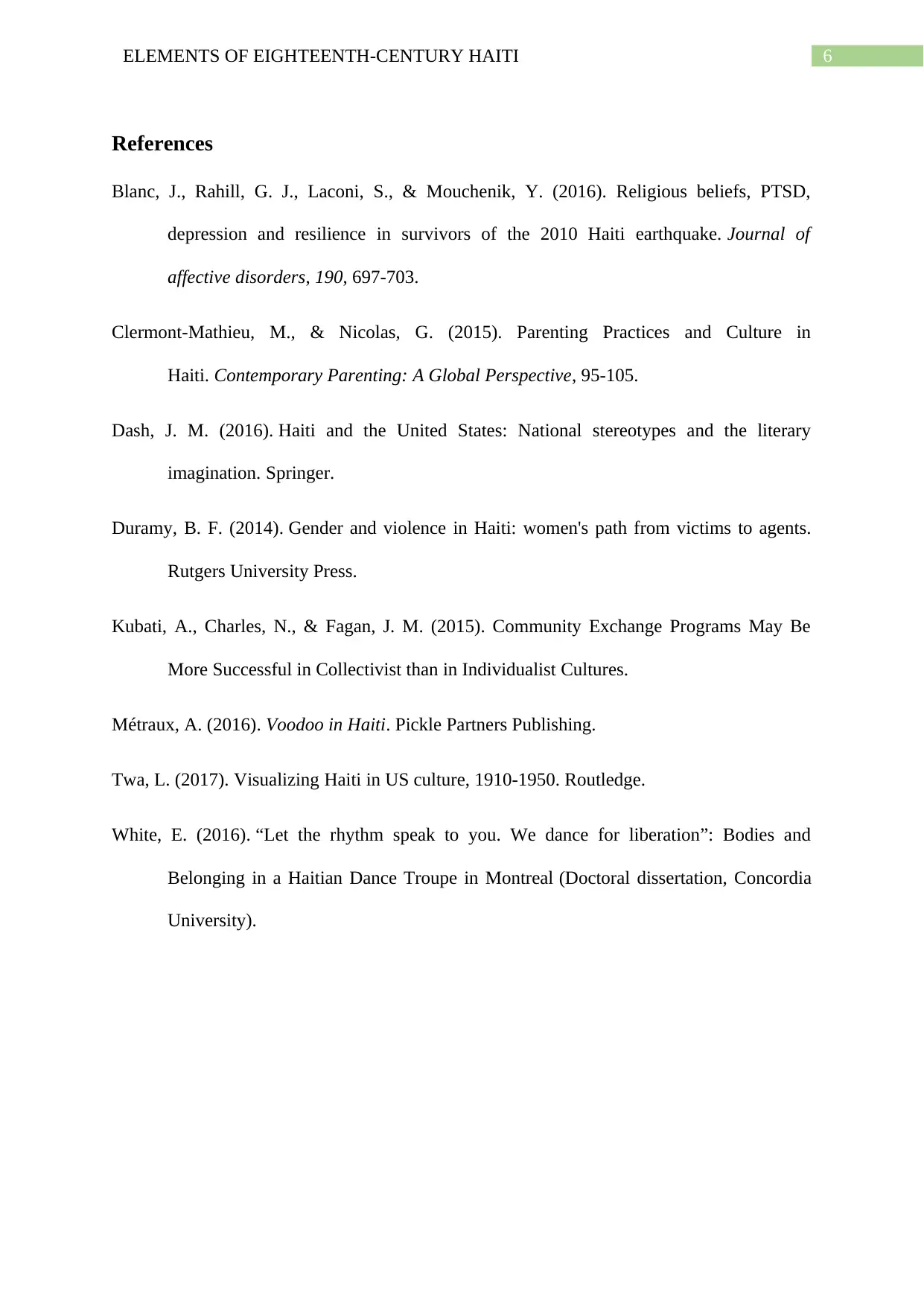
6ELEMENTS OF EIGHTEENTH-CENTURY HAITI
References
Blanc, J., Rahill, G. J., Laconi, S., & Mouchenik, Y. (2016). Religious beliefs, PTSD,
depression and resilience in survivors of the 2010 Haiti earthquake. Journal of
affective disorders, 190, 697-703.
Clermont-Mathieu, M., & Nicolas, G. (2015). Parenting Practices and Culture in
Haiti. Contemporary Parenting: A Global Perspective, 95-105.
Dash, J. M. (2016). Haiti and the United States: National stereotypes and the literary
imagination. Springer.
Duramy, B. F. (2014). Gender and violence in Haiti: women's path from victims to agents.
Rutgers University Press.
Kubati, A., Charles, N., & Fagan, J. M. (2015). Community Exchange Programs May Be
More Successful in Collectivist than in Individualist Cultures.
Métraux, A. (2016). Voodoo in Haiti. Pickle Partners Publishing.
Twa, L. (2017). Visualizing Haiti in US culture, 1910-1950. Routledge.
White, E. (2016). “Let the rhythm speak to you. We dance for liberation”: Bodies and
Belonging in a Haitian Dance Troupe in Montreal (Doctoral dissertation, Concordia
University).
References
Blanc, J., Rahill, G. J., Laconi, S., & Mouchenik, Y. (2016). Religious beliefs, PTSD,
depression and resilience in survivors of the 2010 Haiti earthquake. Journal of
affective disorders, 190, 697-703.
Clermont-Mathieu, M., & Nicolas, G. (2015). Parenting Practices and Culture in
Haiti. Contemporary Parenting: A Global Perspective, 95-105.
Dash, J. M. (2016). Haiti and the United States: National stereotypes and the literary
imagination. Springer.
Duramy, B. F. (2014). Gender and violence in Haiti: women's path from victims to agents.
Rutgers University Press.
Kubati, A., Charles, N., & Fagan, J. M. (2015). Community Exchange Programs May Be
More Successful in Collectivist than in Individualist Cultures.
Métraux, A. (2016). Voodoo in Haiti. Pickle Partners Publishing.
Twa, L. (2017). Visualizing Haiti in US culture, 1910-1950. Routledge.
White, E. (2016). “Let the rhythm speak to you. We dance for liberation”: Bodies and
Belonging in a Haitian Dance Troupe in Montreal (Doctoral dissertation, Concordia
University).
1 out of 7
Your All-in-One AI-Powered Toolkit for Academic Success.
+13062052269
info@desklib.com
Available 24*7 on WhatsApp / Email
![[object Object]](/_next/static/media/star-bottom.7253800d.svg)
Unlock your academic potential
© 2024 | Zucol Services PVT LTD | All rights reserved.
